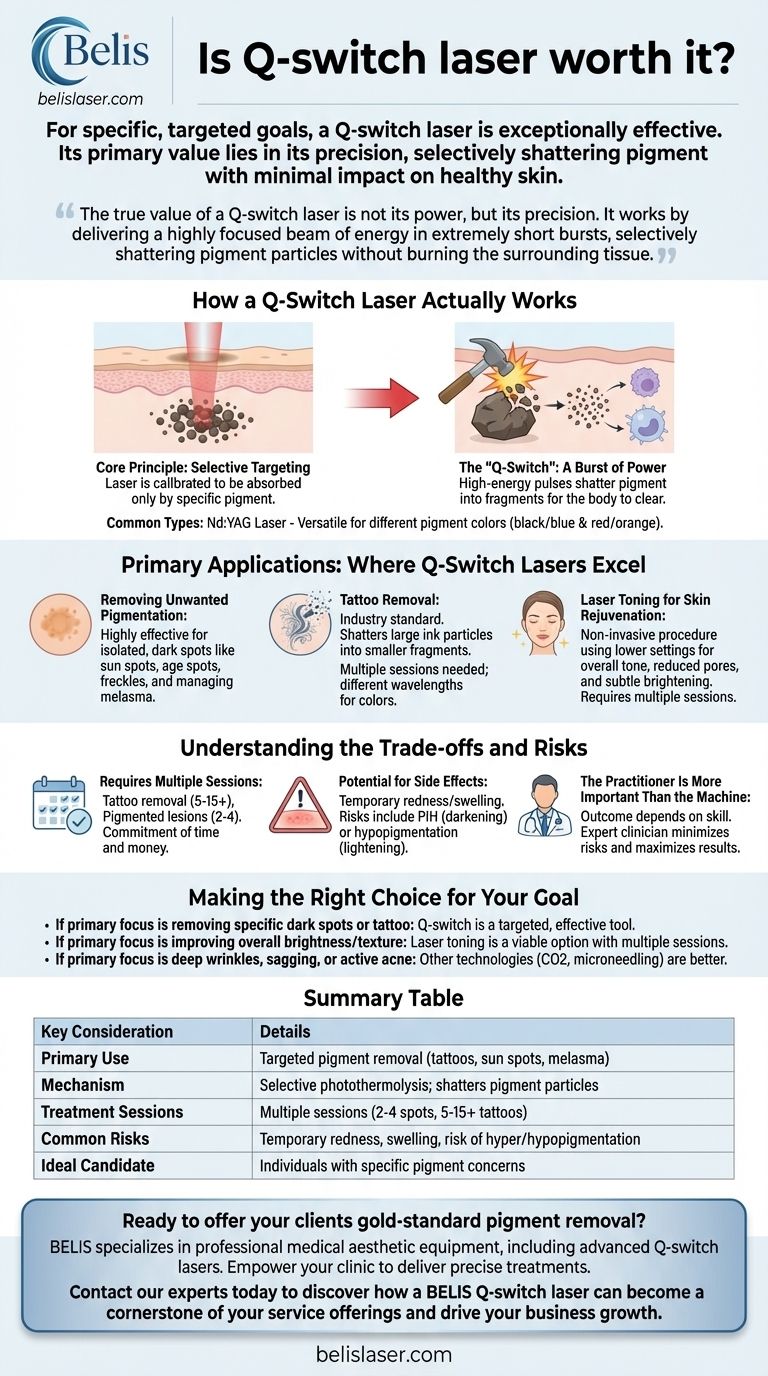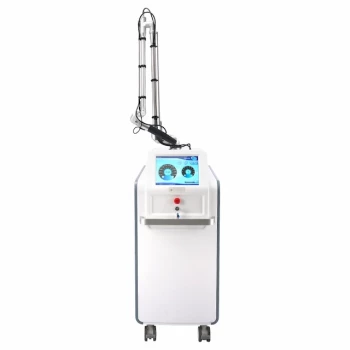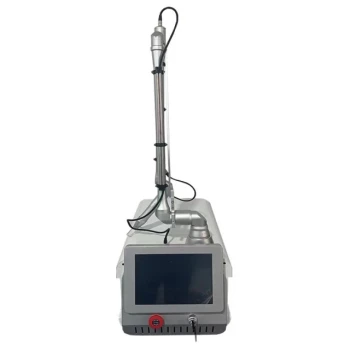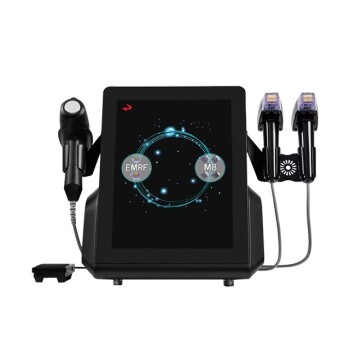For specific, targeted goals, a Q-switch laser is an exceptionally effective and worthwhile technology. Its primary value lies in its precision, allowing it to destroy pigment from tattoos, sun spots, or melasma with minimal impact on the surrounding healthy skin. While not a cure-all, it is considered a gold-standard treatment for many pigment-related concerns.
The true value of a Q-switch laser is not its power, but its precision. It works by delivering a highly focused beam of energy in extremely short bursts, selectively shattering pigment particles without burning the surrounding tissue, making it a premier tool for clearing unwanted spots and ink.

How a Q-Switch Laser Actually Works
To understand if this laser is right for you, you first need to understand its unique mechanism. It isn't a general resurfacing tool; it's a highly specialized instrument designed for a specific task.
The Core Principle: Selective Targeting
A Q-switch laser operates on the principle of selective photothermolysis. This means it's calibrated to be absorbed only by specific colors, or pigments, in the skin.
The laser passes harmlessly through the upper layers of your skin and is absorbed by the concentrated pigment found in a sun spot or tattoo ink.
The "Q-Switch": A Burst of Power
The "Q-switch" is a component inside the laser that acts like a high-speed shutter. It allows the device to produce extremely brief but high-energy pulses of light.
Think of it like shattering a rock. A slow, steady push won't break it. But a quick, powerful strike with a hammer (the Q-switch pulse) shatters it into tiny pieces that the body's immune system can then clear away.
Common Types: The Nd:YAG Laser
The Q-switched Nd:YAG laser is one of the most common types. It is versatile because it can produce two different wavelengths of light: one that is highly effective against black and blue pigments, and another that works well on red and orange pigments.
Primary Applications: Where Q-Switch Lasers Excel
This technology is not a general-purpose anti-aging device. Its worth is determined by its effectiveness on a few key conditions.
Removing Unwanted Pigmentation
This is the laser's strongest application. It is highly effective for isolated, dark spots such as sun spots (lentigines), age spots, and freckles. It is also a primary treatment for managing the complex pigmentation of melasma.
Tattoo Removal
Q-switch lasers are the industry standard for tattoo removal. The laser shatters the large ink particles embedded in the skin into smaller fragments.
Over a series of treatments, the body's natural processes flush these tiny particles away, causing the tattoo to fade. Different wavelengths are required to target different ink colors effectively.
Laser Toning for Skin Rejuvenation
A gentler application, often called "laser toning," involves using the Q-switch laser at a lower setting across the entire face.
This non-invasive procedure can help improve overall skin tone, reduce the appearance of pores, and provide a subtle brightening effect by targeting diffuse, low-level pigmentation. This requires multiple sessions to see significant results.
Understanding the Trade-offs and Risks
No procedure is without its compromises. Objectivity requires understanding both the benefits and the potential downsides before deciding if it's "worth it."
It Requires Multiple Sessions
A single treatment is rarely enough. For tattoo removal, 5 to 15+ sessions may be needed. For pigmented lesions, 2 to 4 sessions are common. This commitment of time and money is a critical factor in its overall worth.
Potential for Side Effects
While generally safe when performed by an expert, risks exist. The most common side effects are temporary redness and swelling.
More serious risks include post-inflammatory hyperpigmentation (PIH), where the skin darkens in response to the treatment, especially in darker skin tones. Conversely, hypopigmentation (lightening of the skin) can also occur.
The Practitioner Is More Important Than the Machine
The outcome is highly dependent on the skill and experience of the clinician. An expert practitioner knows how to adjust the laser's settings for your specific skin type and condition, minimizing risks and maximizing results. The best technology in the wrong hands can be ineffective or even dangerous.
Making the Right Choice for Your Goal
Ultimately, the value of a Q-switch laser is directly tied to your specific skin concern. Use this guide to determine if it aligns with your objectives.
- If your primary focus is removing specific dark spots or an unwanted tattoo: The Q-switch laser is one of the most targeted and effective tools available for this purpose.
- If your primary focus is improving overall brightness and subtle texture issues: Laser toning with a Q-switch is a viable, low-downtime option, but you must be prepared for a series of treatments.
- If your primary focus is treating deep wrinkles, significant sagging, or active acne: Other technologies, such as CO2 fractional lasers, microneedling with radiofrequency, or medical treatments, will likely provide better results.
By matching the right tool to the right problem, you ensure your investment in any cosmetic procedure is a worthy one.
Summary Table:
| Key Consideration | Details |
|---|---|
| Primary Use | Targeted pigment removal (tattoos, sun spots, melasma) |
| Mechanism | Selective photothermolysis; shatters pigment particles |
| Treatment Sessions | Multiple sessions required (2-4 for spots, 5-15+ for tattoos) |
| Common Risks | Temporary redness, swelling, risk of hyper/hypopigmentation |
| Ideal Candidate | Individuals with specific pigment concerns, not general anti-aging |
Ready to offer your clients gold-standard pigment removal?
BELIS specializes in professional medical aesthetic equipment, including advanced Q-switch lasers. Our technology empowers medical aesthetics clinics and premium beauty salons to deliver precise, effective treatments for tattoos, sun spots, and melasma.
Contact our experts today to discover how a BELIS Q-switch laser can become a cornerstone of your service offerings and drive your business growth.
Visual Guide

Related Products
- Pico Laser Tattoo Removal Machine Picosure Picosecond Laser Machine
- Q Switch Nd Yag Laser Machine Tattoo Removal Nd Yag Machine
- Pico Picosecond Laser Machine for Tattoo Removal Picosure Pico Laser
- Clinic Use IPL and SHR Hair Removal Machine with Nd Yag Laser Tattoo Removal
- Diode Laser SHR Trilaser Hair Removal Machine for Clinic Use
People Also Ask
- What is the disadvantage of Pico laser treatment? Understand the Risks and Costs Before You Decide
- What is the case of most adverse reactions after laser? Prevent Post-Inflammatory Hyperpigmentation
- How does a medical laser work? Unlock the Power of Selective Photothermolysis
- Who is suitable for Pico laser? A Guide for Tattoo Removal, Pigmentation & Acne Scars
- Who should not do pico laser? Key Contraindications for Safe Treatment



















